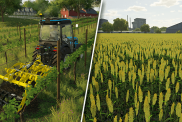You can build farms in Dwarf Fortress anywhere with soil or mud covering. However, what crops you can plant depends on several factors that might leave beginners frustrated. Fortunately, farms have a relatively simple set of rules and aren’t as complicated as they may seem at first glance.
How to build a farm in Dwarf Fortress
You can build a farm on any soil tile in Dwarf Fortress. This includes:
Topsoil
- Loam
- Loamy sand
- Peat
- Sandy clay loam
- Sandy loam
- Silt
- Silty clay loam
- Silt loam
Ocean Floor
- Pelagic clay
- Siliceous ooze
- Calcareous ooze
Sand
- Sand
- Black sand
- Red sand
- White sand
- Yellow sand
Clay
- Clay
- Clay loam
- Fire clay
- Sandy clay
- Silty clay
You can also farm on muddy tiles, which can be created using irrigation.
Once you’ve found an appropriate location for your farm, plot it out and confirm. Then, any dwarf with the Farming (Fields) labor assigned will begin clearing the plot and preparing it for planting. If you notice that the farm isn’t getting built, ensure at least one dwarf has that labor assigned.
How to plant crops
Once a field is prepared in Dwarf Fortress, you’ll need to choose a crop to plant for each of the four seasons. Note that there are many plants you can grow in the game, but not all of them are crops.
All crops in Dwarf Fortress have a couple of things in common:
- First, they grow in every season.
- They can be grown from seeds.
The main info you need to know about a crop is within which biome it can be grown and whether it grows above or below ground, which we include in our list below:
List of above-ground crops
- Alfalfa: Any biome not freezing
- Barley: Any biome not freezing
- Bitter vetch: Any Temperate
- Blood amaranth: Any tropical
- Buckwheat: Tropical Dry Broadleaf Forest
- Cotton: Any tropical
- Elephant-head amaranth: Any tropical
- Finger millet: Any Temperate
- Flax: Tropical Grassland, Tropical Savanna
- Fonio: Tropical Savanna
- Foxtail millet: Any Temperate
- Hard wheat: Tropical Grassland, Tropical Savanna
- Hemp: Any Temperate
- Jute: Any tropical
- Kaniwa: Any Temperate
- Kenaf: Any tropical
- Maize: Any tropical
- Oats: Any Temperate
- Papyrus sedge: Any Tropical Wetland
- Pearl millet: Any tropical
- Pendant amaranth: Any tropical
- Purple amaranth: Any Temperate
- Quinoa: Any Temperate
- Ramie: Any tropical
- Red spinach: Any biome not freezing
- Rice: Any tropical
- Rye: Any biome not freezing
- Single-grain wheat: Tropical Grassland, Tropical Savanna
- Soft wheat: Tropical Grassland, Tropical Savanna
- Sorghum: Tropical Grassland, Tropical Savanna
- Spelt: Any Temperate
- Teff: Tropical Grassland
- Two-grain wheat: Tropical Grassland, Tropical Savanna
- White millet: Any Temperate
List of garden plants
Garden plants are more demanding than crops. Some of them have seasonal requirements of which you’ll need to be aware.
- Artichoke: Temperate Grassland
- Asparagus: Any Temperate
- Bambara groundnut: Tropical Dry Broadleaf Forest, Tropical Grassland, Tropical Savanna, Tropical Shrubland
- Beet: Temperate Grassland
- Bilberry: Any Temperate, Tundra, Taiga
- Bitter melon: Any Tropical
- Blackberry: Any Temperate
- Blueberry: Any Temperate, Tundra, Taiga
- Broad Bean: Any Temperate
- Cabbage: Any Temperate
- Caper: Any Desert, Any Grassland
- Cassava: Any Tropical
- Celery: Any Temperate
- Chickpea: Any Tropical
- Chicory: Any Temperate
- Cowpea: Tropical Grassland
- Cranberry: Any Temperate, Tundra, Taiga
- Cucumber: Tropical Dry Broadleaf Forest, Tropical Grassland, Tropical Savanna, Tropical Shrubland
- Eggplant: Tropical Dry Broadleaf Forest, Tropical Grassland, Tropical Savanna, Tropical Shrubland
- Garden cress: Any Temperate
- Garlic: Any Temperate
- Grape: Any Temperate
- Horned melon: Any Tropical
- Leek: Any Temperate
- Lentil: Any biome not freezing
- Lesser yam: Any Tropical
- Lettuce: Tropical Dry Broadleaf Forest, Tropical Grassland, Tropical Savanna, Tropical Shrubland, Any Temperate
- Long yam: Any Temperate
- Mung bean: Any Tropical
- Muskmelon: Tropical Dry Broadleaf Forest, Tropical Grassland, Tropical Savanna, Tropical Shrubland, Any Temperate
- Onion: Any Temperate
- Parsnip: Any Temperate
- Passion fruit: Any Tropical
- Pea: Any Temperate
- Peanut: Tropical Dry Broadleaf Forest, Tropical Grassland, Tropical Savanna, Tropical Shrubland
- Pepper: Any Tropical
- Pineapple: Any Tropical
- Potato: Any biome not freezing
- Purple yam: Any Tropical
- Radish: Any Temperate
- Raspberry: Any Temperate
- Red Bean: Any Temperate
- Rhubarb: Any Temperate
- Soybean: Any Temperate
- Spinach: Any Temperate
- Squash: Any Tropical
- String Bean: Any Temperate
- Sweet potato: Any Tropical
- Taro: Any Tropical
- Tomatillo: Tropical Dry Broadleaf Forest, Tropical Grassland, Tropical Savanna, Tropical Shrubland
- Turnip: Any Temperate
- Urad bean: Any Tropical
- Watermelon: Any Tropical
- White yam: Any Tropical
- Wild Carrot: Any Temperate
- Winter melon: Any Tropical
Subterranean Plants
You must plant these plants (which are really fungi) underground.
- Cave wheat: Subterranean Water
- Dimple cup: Subterranean Water
- Pig tail: Subterranean Water
- Plump helmet: Subterranean Water
- Quarry bush: Subterranean Water
- Sweet pod: Subterranean Water
Misc Plants
- Blade weed: Any biome not freezing
- Bloated tuber: Any Wetland
- Fisher berry: Any biome not freezing
- Hide root: Any biome not freezing
- Longland grass: Any biome not freezing
- Muck root: Any Wetland
- Prickle berry: Any biome not freezing
- Rat weed: Any biome not freezing
- Rope reed: Any biome not freezing
- Silver barb: Any biome not freezing
- Strawberry: Any biome not freezing
- Sun berry: Any biome not freezing
- Valley herb: Temperate grassland
- Whip wine: Any biome not freezing
How to harvest crops
Once crops are grown in Dwarf Fortress, all dwarves can help harvest as it doesn’t take any particular skill. Once plants are harvested, your hauler dwarves will take their various products to the correct stockpile. How much you’ll yield with each planet depends on your farmer’s skill level and whether or not you use fertilizer.
One thing to note is that if harvested plants aren’t moved to a stockpile, they’ll eventually wither and rot. So, when harvest time comes, it might be wise to divert some of your dwarves from their normal activities temporarily so they can help haul.
You can pick up the latest version of Dwarf Fortress right now on Steam.











